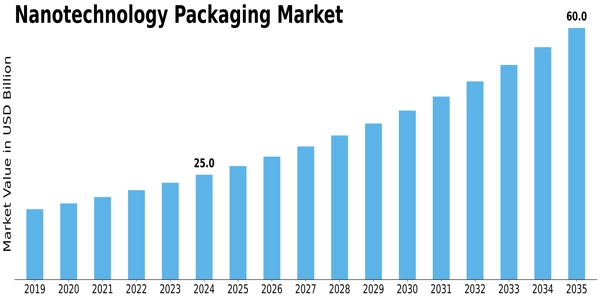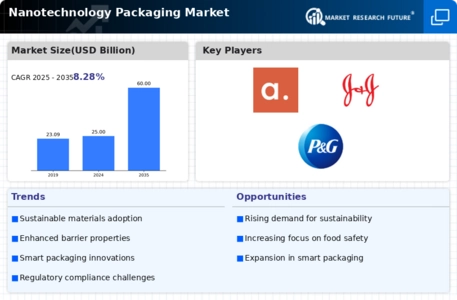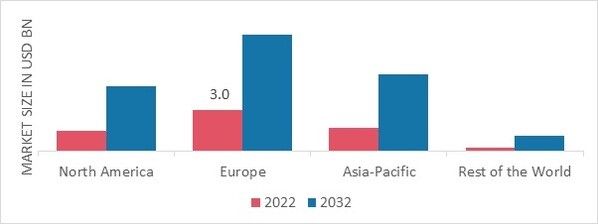-
EXECUTIVE SUMMARY
-
MARKET INTRODUCTION
-
Definition
-
Scope of the Study
- Research Objective
- Assumptions
- Limitations
-
RESEARCH METHODOLOGY
-
3.1.
-
Overview
-
Data Mining
-
Secondary Research
-
Primary Research
- Primary Interviews and Information Gathering Process
- Breakdown
-
of Primary Respondents
-
Forecasting Modality
-
Market Size Estimation
- Bottom-Up Approach
- Top-Down Approach
-
Data Triangulation
-
Validation
-
MARKET DYNAMICS
-
Overview
-
Drivers
-
Restraints
-
Opportunities
-
MARKET FACTOR ANALYSIS
-
5.1.
-
Value Chain Analysis
-
Porter’s Five Forces Analysis
- Bargaining
- Bargaining Power of Buyers
- Threat of
- Threat of Substitutes
- Intensity of Rivalry
-
Power of Suppliers
-
New Entrants
-
COVID-19 Impact Analysis
- Market Impact Analysis
- Regional
- Opportunity and Threat Analysis
-
Impact
-
GLOBAL NANOTECHNOLOGY
-
PACKAGING MARKET, BY TYPE
-
Overview
-
Active Packaging
-
6.3.
-
Controlled Release Packaging
-
Intelligent Packaging
-
GLOBAL NANOTECHNOLOGY
-
PACKAGING MARKET, BY APPLICATION
-
Overview
-
Food & Beverages
-
Pharmaceutical
-
Personal Care & Cosmetics
-
Others
-
GLOBAL NANOTECHNOLOGY PACKAGING MARKET, BY REGION
-
Overview
- U.S.
- Canada
-
8.2.
-
North America
-
Europe
- Germany
- France
- U.K
- Italy
- Spain
-
8.3.6.
-
Rest of Europe
-
Asia-Pacific
- China
- India
- South Korea
- Australia
- Rest of Asia-Pacific
-
8.4.3.
-
Japan
-
Rest of the World
- Middle East
- Africa
-
8.5.3.
-
Latin America
-
COMPETITIVE LANDSCAPE
-
Overview
-
Competitive
-
Analysis
-
Market Share Analysis
-
Major Growth Strategy in the
-
Global Nanotechnology Packaging Market,
-
Competitive Benchmarking
-
9.6.
-
Leading Players in Terms of Number of Developments in the Global Nanotechnology
-
Packaging Market,
-
Key developments and Growth Strategies
- New
- Merger & Acquisitions
-
TYPE Launch/Application Deployment
-
9.7.3.
-
Joint Ventures
-
Major Players Financial Matrix
- Sales &
- Major Players R&D Expenditure. 2022
-
Operating Income, 2022
-
10.
-
COMPANY PROFILES
-
Bemis Company, Inc.
- Company Overview
- Financial Overview
- Type Offered
- Key Developments
- SWOT Analysis
- Key Strategies
-
Amcor Limited
- Company Overview
- Financial Overview
- Type Offered
- Key Developments
- SWOT Analysis
- Key Strategies
-
3M Company
- Company Overview
- Financial Overview
- Type Offered
- Key Developments
- SWOT Analysis
- Key Strategies
-
Chevron Phillips Chemical Company LLC
- Financial Overview
- Type Offered
- SWOT Analysis
- Key Strategies
- Company Overview
- Financial
- Type Offered
- Key Developments
- SWOT
- Key Strategies
-
10.4.1.
-
Company Overview
-
10.4.4.
-
Key Developments
-
10.5.
-
Honeywell International Inc.
-
Overview
-
Analysis
-
APPENDIX
-
References
-
Related Reports
-
-
LIST OF TABLES
-
GLOBAL NANOTECHNOLOGY
-
PACKAGING MARKET, SYNOPSIS, 2025-2034
-
GLOBAL NANOTECHNOLOGY PACKAGING
-
MARKET, ESTIMATES & FORECAST, 2025-2034 (USD BILLION)
-
GLOBAL NANOTECHNOLOGY
-
PACKAGING MARKET, BY TYPE, 2025-2034 (USD BILLION)
-
GLOBAL NANOTECHNOLOGY
-
PACKAGING MARKET, BY APPLICATION, 2025-2034 (USD BILLION)
-
NORTH AMERICA
-
NANOTECHNOLOGY PACKAGING MARKET, BY TYPE, 2025-2034 (USD BILLION)
-
NORTH
-
AMERICA NANOTECHNOLOGY PACKAGING MARKET, BY APPLICATION, 2025-2034 (USD BILLION)
-
NORTH AMERICA NANOTECHNOLOGY PACKAGING MARKET, BY COUNTRY, 2025-2034 (USD
-
BILLION)
-
U.S. NANOTECHNOLOGY PACKAGING MARKET, BY TYPE, 2025-2034 (USD
-
BILLION)
-
U.S. NANOTECHNOLOGY PACKAGING MARKET, BY APPLICATION, 2025-2034
-
(USD BILLION)
-
CANADA NANOTECHNOLOGY PACKAGING MARKET, BY TYPE, 2025-2034
-
(USD BILLION)
-
CANADA NANOTECHNOLOGY PACKAGING MARKET, BY APPLICATION,
-
EUROPE NANOTECHNOLOGY PACKAGING MARKET, BY
-
TYPE, 2025-2034 (USD BILLION)
-
EUROPE NANOTECHNOLOGY PACKAGING MARKET,
-
BY APPLICATION, 2025-2034 (USD BILLION)
-
EUROPE NANOTECHNOLOGY PACKAGING
-
MARKET, BY COUNTRY, 2025-2034 (USD BILLION)
-
GERMANY NANOTECHNOLOGY
-
PACKAGING MARKET, BY TYPE, 2025-2034 (USD BILLION)
-
GERMANY NANOTECHNOLOGY
-
PACKAGING MARKET, BY APPLICATION, 2025-2034 (USD BILLION)
-
FRANCE NANOTECHNOLOGY
-
PACKAGING MARKET, BY TYPE, 2025-2034 (USD BILLION)
-
FRANCE NANOTECHNOLOGY
-
PACKAGING MARKET, BY APPLICATION, 2025-2034 (USD BILLION)
-
ITALY NANOTECHNOLOGY
-
PACKAGING MARKET, BY TYPE, 2025-2034 (USD BILLION)
-
ITALY NANOTECHNOLOGY
-
PACKAGING MARKET, BY APPLICATION, 2025-2034 (USD BILLION)
-
SPAIN NANOTECHNOLOGY
-
PACKAGING MARKET, BY TYPE, 2025-2034 (USD BILLION)
-
SPAIN NANOTECHNOLOGY
-
PACKAGING MARKET, BY APPLICATION, 2025-2034 (USD BILLION)
-
U.K NANOTECHNOLOGY
-
PACKAGING MARKET, BY TYPE, 2025-2034 (USD BILLION)
-
U.K NANOTECHNOLOGY
-
PACKAGING MARKET, BY APPLICATION, 2025-2034 (USD BILLION)
-
REST OF
-
EUROPE NANOTECHNOLOGY PACKAGING MARKET, BY TYPE, 2025-2034 (USD BILLION)
-
TABLE
-
REST OF EUROPE NANOTECHNOLOGY PACKAGING MARKET, BY APPLICATION, 2025-2034 (USD
-
BILLION)
-
ASIA PACIFIC NANOTECHNOLOGY PACKAGING MARKET, BY TYPE, 2025-2034
-
(USD BILLION)
-
ASIA PACIFIC NANOTECHNOLOGY PACKAGING MARKET, BY APPLICATION,
-
ASIA PACIFIC NANOTECHNOLOGY PACKAGING MARKET,
-
BY COUNTRY, 2025-2034 (USD BILLION)
-
JAPAN NANOTECHNOLOGY PACKAGING
-
MARKET, BY TYPE, 2025-2034 (USD BILLION)
-
JAPAN NANOTECHNOLOGY PACKAGING
-
MARKET, BY APPLICATION, 2025-2034 (USD BILLION)
-
CHINA NANOTECHNOLOGY
-
PACKAGING MARKET, BY TYPE, 2025-2034 (USD BILLION)
-
CHINA NANOTECHNOLOGY
-
PACKAGING MARKET, BY APPLICATION, 2025-2034 (USD BILLION)
-
INDIA NANOTECHNOLOGY
-
PACKAGING MARKET, BY TYPE, 2025-2034 (USD BILLION)
-
INDIA NANOTECHNOLOGY
-
PACKAGING MARKET, BY APPLICATION, 2025-2034 (USD BILLION)
-
AUSTRALIA
-
NANOTECHNOLOGY PACKAGING MARKET, BY TYPE, 2025-2034 (USD BILLION)
-
TABLE 37
-
AUSTRALIA NANOTECHNOLOGY PACKAGING MARKET, BY APPLICATION, 2025-2034 (USD BILLION)
-
SOUTH KOREA NANOTECHNOLOGY PACKAGING MARKET, BY TYPE, 2025-2034 (USD
-
BILLION)
-
SOUTH KOREA NANOTECHNOLOGY PACKAGING MARKET, BY APPLICATION,
-
REST OF ASIA-PACIFIC NANOTECHNOLOGY PACKAGING
-
MARKET, BY TYPE, 2025-2034 (USD BILLION)
-
REST OF ASIA-PACIFIC NANOTECHNOLOGY
-
PACKAGING MARKET, BY APPLICATION, 2025-2034 (USD BILLION)
-
REST OF
-
WORLD NANOTECHNOLOGY PACKAGING MARKET, BY TYPE, 2025-2034 (USD BILLION)
-
TABLE
-
REST OF WORLD NANOTECHNOLOGY PACKAGING MARKET, BY APPLICATION, 2025-2034 (USD
-
BILLION)
-
REST OF WORLD NANOTECHNOLOGY PACKAGING MARKET, BY COUNTRY,
-
MIDDLE EAST NANOTECHNOLOGY PACKAGING MARKET,
-
BY TYPE, 2025-2034 (USD BILLION)
-
MIDDLE EAST NANOTECHNOLOGY PACKAGING
-
MARKET, BY APPLICATION, 2025-2034 (USD BILLION)
-
AFRICA NANOTECHNOLOGY
-
PACKAGING MARKET, BY TYPE, 2025-2034 (USD BILLION)
-
AFRICA NANOTECHNOLOGY
-
PACKAGING MARKET, BY APPLICATION, 2025-2034 (USD BILLION)
-
LATIN AMERICA
-
NANOTECHNOLOGY PACKAGING MARKET, BY TYPE, 2025-2034 (USD BILLION)
-
TABLE 50
-
LATIN AMERICA NANOTECHNOLOGY PACKAGING MARKET, BY APPLICATION, 2025-2034 (USD BILLION)
-
-
LIST OF FIGURES
-
RESEARCH PROCESS
-
MARKET
-
STRUCTURE FOR THE GLOBAL NANOTECHNOLOGY PACKAGING MARKET
-
MARKET DYNAMICS
-
FOR THE GLOBAL NANOTECHNOLOGY PACKAGING MARKET
-
GLOBAL NANOTECHNOLOGY
-
PACKAGING MARKET, SHARE (%), BY TYPE, 2022
-
GLOBAL NANOTECHNOLOGY PACKAGING
-
MARKET, SHARE (%), BY APPLICATION, 2022
-
GLOBAL NANOTECHNOLOGY PACKAGING
-
MARKET, SHARE (%), BY REGION, 2022
-
NORTH AMERICA: NANOTECHNOLOGY PACKAGING
-
MARKET, SHARE (%), BY REGION, 2022
-
EUROPE: NANOTECHNOLOGY PACKAGING
-
MARKET, SHARE (%), BY REGION, 2022
-
ASIA-PACIFIC: NANOTECHNOLOGY PACKAGING
-
MARKET, SHARE (%), BY REGION, 2022
-
REST OF THE WORLD: NANOTECHNOLOGY
-
PACKAGING MARKET, SHARE (%), BY REGION, 2022
-
GLOBAL NANOTECHNOLOGY
-
PACKAGING MARKET: COMPANY SHARE ANALYSIS, 2022 (%)
-
BEMIS COMPANY,
-
INC.: FINANCIAL OVERVIEW SNAPSHOT
-
BEMIS COMPANY, INC.: SWOT ANALYSIS
-
AMCOR LIMITED: FINANCIAL OVERVIEW SNAPSHOT
-
AMCOR LIMITED:
-
SWOT ANALYSIS
-
3M COMPANY: FINANCIAL OVERVIEW SNAPSHOT
-
FIGURE
-
3M COMPANY: SWOT ANALYSIS
-
CHEVRON PHILLIPS CHEMICAL COMPANY LLC:
-
FINANCIAL OVERVIEW SNAPSHOT
-
CHEVRON PHILLIPS CHEMICAL COMPANY LLC:
-
SWOT ANALYSIS
-
HONEYWELL INTERNATIONAL INC.: FINANCIAL OVERVIEW SNAPSHOT
-
HONEYWELL INTERNATIONAL INC.: SWOT ANALYSIS








Leave a Comment